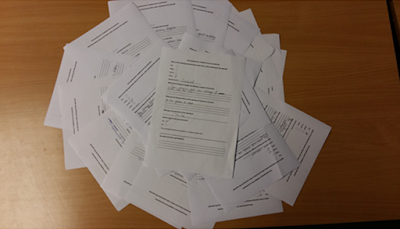Shots are edited together in sequence to form a production. How this production is encoded and decoded by the demographic can depend on way the shots are edited together. I have given a brief explanation of each editing technique and added a working example I have analysed to which I will use as examples. The shots include;
Eyeline Match
Eyeline Match
Eyeline match is when there are two shots present edited together. One being the subject looking at another subject or an object off screen, it is then edited to the subject/object that the first subject was looking at. To ensure this editing shot is used effectively and in a realistic manner, the eyeline of the subjects and the object of the next shot must match. If the eyelines don't match the subject will look like their looking at something else off frame.
A video example of eyeline match can be seen below:
A video example of eyeline match can be seen below:
Cross Cutting
Cross cutting editing is editing action that's happening in two different locations together.
For example in one shot, two subjects are having a fight in the classroom, in the next shot a different character is walking down the hallway.
A video example of cross cutting is below:
Focus Pull
Focus pull or otherwise known as shift of focus is when the focus is adjusted from one subject to another, in the frame, to a deep or shallow depth of field.
A video example of focus pull is below:
Focus pull or otherwise known as shift of focus is when the focus is adjusted from one subject to another, in the frame, to a deep or shallow depth of field.
A video example of focus pull is below:
Jump Cut
Jump cuts are when two short shots of the same action, however the camera angle slightly moves in each shot.
A video example of jump cut is below:
Jump cuts are when two short shots of the same action, however the camera angle slightly moves in each shot.
A video example of jump cut is below:
Montage
Montage shots are a series of shots that are edited together into a sequence to condense, space, time and information.
A video example of montage is below:
Time Remapping
Time remapping is when the shot is in either slow or fast motion.
A video example of time reamapping is below:
Montage shots are a series of shots that are edited together into a sequence to condense, space, time and information.
A video example of montage is below:
Time Remapping
Time remapping is when the shot is in either slow or fast motion.
A video example of time reamapping is below:
Zolly Shot
Zolly shot is the camera movement of a zoom and dolly shot used together by moving the camera back on a dolly and zooming in to create the illusion that life is changing.
A video example of zolly shot is below:
Zolly shot is the camera movement of a zoom and dolly shot used together by moving the camera back on a dolly and zooming in to create the illusion that life is changing.
A video example of zolly shot is below:
Graphic Match
This is a French term for cutting and editing between either, two different objects, spaces or compositions which graphically match.
A video example of graphic match is below:
This is a French term for cutting and editing between either, two different objects, spaces or compositions which graphically match.
A video example of graphic match is below:
Flash Cutting
Flash cutting is a series of quick shots that have a sense of rhythm to them.
A video example of flash cutting is below:
Flash cutting is a series of quick shots that have a sense of rhythm to them.
A video example of flash cutting is below:
Subliminal Cut
Subliminal cuts is a cut hidden because the editing is so fast, therefore it is unable to be detected by the demographic.
Elliptical Editing
This editing technique is similar to montage editing however this uses text to inform the target audience so connote a sense of time passing by.
A video example of elliptical editing is below:
Subliminal cuts is a cut hidden because the editing is so fast, therefore it is unable to be detected by the demographic.
Elliptical Editing
This editing technique is similar to montage editing however this uses text to inform the target audience so connote a sense of time passing by.
A video example of elliptical editing is below:
Match on action Editing
Action editing, are cuts of one shot to another view that match the first shot's action.
A video example of action editing is below:
Action editing, are cuts of one shot to another view that match the first shot's action.
A video example of action editing is below:





































